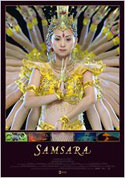

Opening 23 Aug 2012
Directed by:
Ron Fricke
Writing credits:
Ron Fricke, Mark Magidson
The filmmakers Ron Fricke and Mark Magidson describe their non-verbal film a “guided meditation on the cycle of birth, death and rebirth”. Samsara is a Sanskrit word meaning “continuous flow” or the continuous cycle of life. There is no plot to follow but a flow of high-class images keeps you watching in wonder and surprise.
The film team takes us to a variety of places and landscapes from an ash and fire-spitting volcano to ancient temples amidst lush green jungle, but the emphasis is definitely on people. We are made aware of the effect people have on today’s world, see the differences as well as similarities of different cultures. Large close-ups of faces are juxtaposed with awe-inspiring time-lapse cinematography of beautiful locations from sculptured yellow sand dunes to rushing water falls.
Amazingly photographed buildings (e.g., St. Peter’s cathedral in Rome) show what people have achieved in the past or how buildings have crumbled after a natural disaster. We follow workers at an assembly line churning out goods, all of which have to be recycled again. In a mountain of discarded garbage children are eagerly looking for usable items.
The shots are very cleverly intertwined and enhanced by an enchanting music score for which the innovative team of Michael Stearns, Lisa Gerrard and Marcello De Francisci take credit. When observing male prisoners performing their exercise routine, the music changes to a dynamic and powerful hip-hop mix.
No music is needed (just listen to the noise) when thousands of faithful Muslims circle the black cube of the Kaaba in the courtyard of the Great Mosque, during the pilgrimage (Hajj) to Mecca, Saudi Arabia. This is Islam’s holiest site and the excellent wide-angle filming gives an impressive feel for this masse event. (The square can accommodate over 300,000 pilgrims at one time; during the week of Hajj more than two million pilgrims visit Mecca). By contrast, we get a glimpse of a Buddhist monastery surrounded by snow-capped mountains, where a group of monks concentrate on sand-painting a strikingly colourful image of the “Wheel of Life”. After its completion we watch it being destroyed again, as the custom requires it.
Throughout the course of the film creation and destruction play their roles. The filmmakers travelled through 25 countries for about five years and show how the rhythm of our planet links all of humankind. If you let the extraordinary images take you on a journey of the mind, this movie is a stimulating experience.
Samsara had its world premiere at the Toronto Film Festival and is the team’s second film in 70 mm Panavision format, being a sequence to the acclaimed Baraka, 1992. (Birgit Schrumpf)